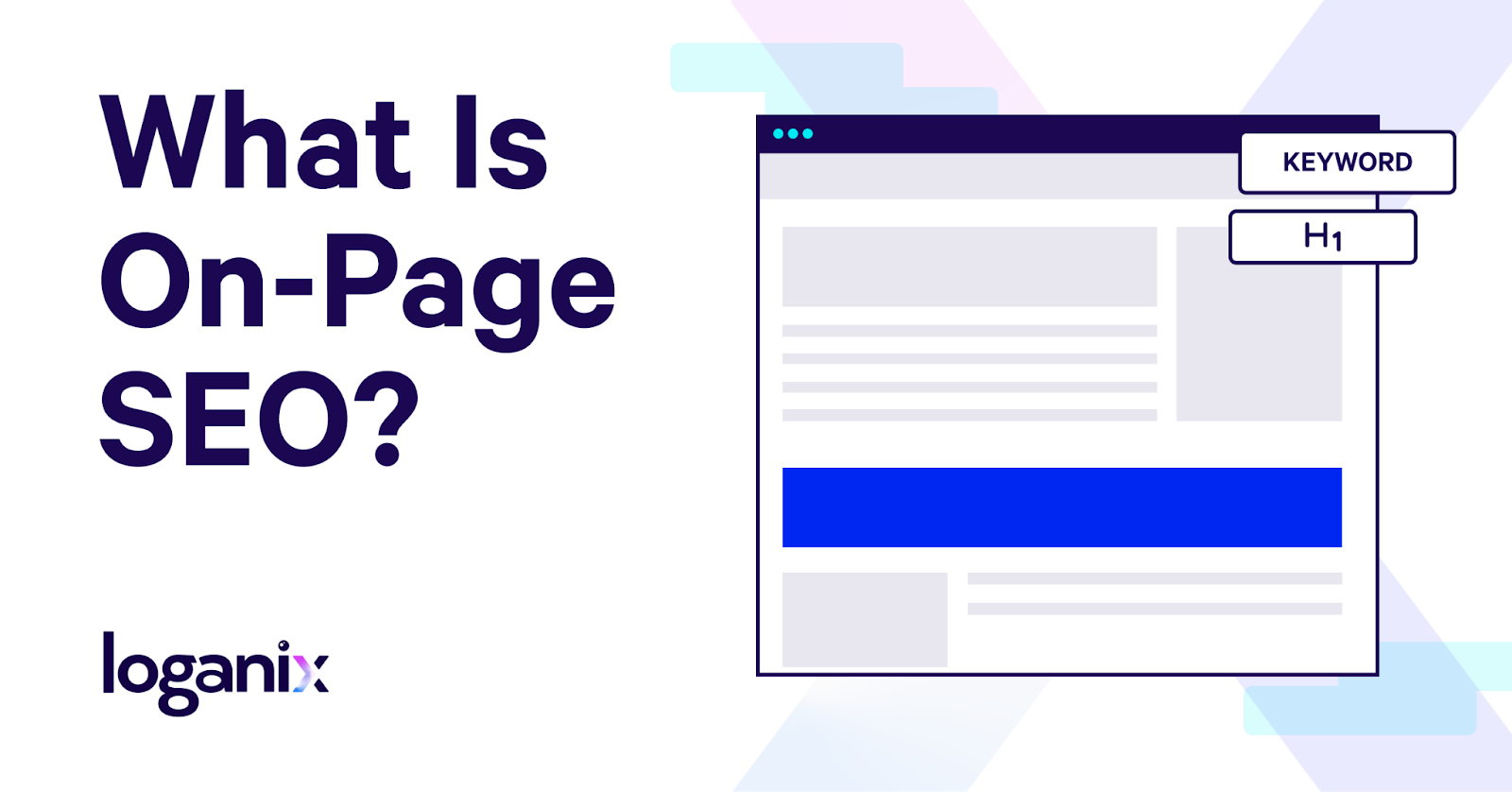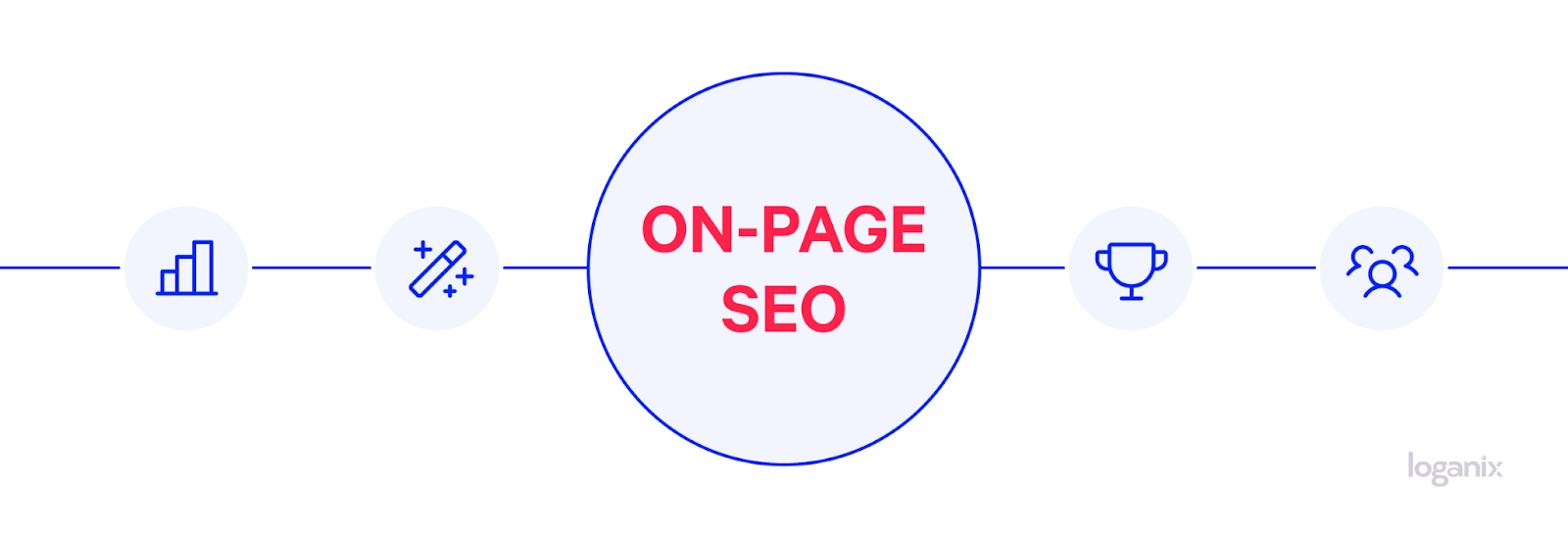What Is On-Page SEO? Content Quality to UX Best Practices

Hand off the toughest tasks in SEO, PPC, and content without compromising quality
Explore ServicesReady to unleash the true power of your website?
It’s time to dive into search engine success with on-page SEO.
To help you along your on-page SEO journey, this comprehensive guide will tackle the questions:
- What is on-page SEO?
- Why it’s important?
- And what tactics do you need to master to propel your website to new heights?
From crafting compelling content to optimizing every pixel-perfect element, we’ve got insider tips and tricks to make your site shine.
What is On-Page SEO?
On-page search engine optimization (SEO) works just as it sounds: optimizing on-page elements that aim to meet the algorithmic preferences of search engines like Google. You know, all those tweaks made to your published content through a content management system (CMS) like WordPress, HubSpot, or Shopify. For example, on-page SEO practices include (but aren’t limited to) crafting compelling, click-worthy title tags, creating high-value content, optimizing URLs, and establishing a robust internal link structure.
Learn more: SEO glossary 250+ terms explained.
Why is On-Page SEO Important?

To put it plainly—perfecting on-page SEO techniques will give your website the best chance at ranking high on the SERPs (search engine result pages).
No ifs, ands, or buts about it.
Specifically, here’s what makes on-page SEO a crucial part of your online strategy.
Better User Experience
A portion of Google’s algorithm is dedicated to assessing the functionality and usability of websites through a set of metrics it calls Core Web Vitals. Core Web Vital metrics measure page performance from a UX perspective, helping Google identify and prioritize high-quality, user-friendly websites in search results.
Optimized UX isn’t all about appeasing the Google Gods, though.
Research shows that 88 percent of internet users claim they will not return to a website after having a bad user experience. So, like Google’s algorithm, website visitors will snub a website if its UX is clunky and unintuitive.
Improved Visibility and Rankings
Google has one primary goal—to deliver relevant and high-quality results to users (after all, that’s their bread and butter and how they make a few bucks on ads, too).
So optimizing on-page elements is essentially telling search engines, “Oi, my site is relevant, user-friendly, and worth checking out.” Then, as a reward for your hard work, Google is more likely to rank your website’s published content higher, sending that sweet organic traffic your way.
Outranking the Competition
Nailing on-page SEO will give you a leg up on your competitors, making attracting and retaining your target audience easier. With this in the bag, your site will rank higher in search results, put it before the eyes of your target audience, and ward off the competition.
On-Page SEO Elements
Next, let’s tackle the on-page SEO strategies and techniques that allow you to optimize your website and achieve higher search rankings.
Content Quality and Relevance
Ensuring your content demonstrates Expertise, Experience, Authoritativeness, and Trustworthiness (E-E-A-T) is a must for improved search engine rankings.
To demonstrate a piece of content’s E-E-A-T, be sure to keep the following in mind:
- Expertise. Showcase your knowledge and expertise in the subject matter by providing in-depth, well-researched, and accurate information. Cite reputable sources, use industry-specific terminology, and share relevant examples or case studies.
- Experience. Share your own experiences, insights, or lessons learned, which build credibility and showcase your understanding of the topic at hand. Include anecdotes, personal stories, or real-life examples demonstrating your hands-on field experience.
- Authoritativeness. Boost your content’s credibility by collaborating with experts, industry leaders, or respected organizations that fill in any knowledge gaps or reinforce the points you’re making within your content. Include quotes, guest contributions, citations, or endorsements from recognized figures in your niche.
- Trustworthiness. Boost your content’s trustworthiness by being transparent, honest, and reliable. Clearly state your sources, provide accurate information, and avoid misleading claims or exaggerations.
So basically, be helpful, not spammy.
Learn more: SEO content writing services.
Keyword Usage and Optimization

Strategically using and optimizing keywords in your content is a proven method to start published content off on the right foot. To show you how this works, let’s quickly touch on some key points here:
- Relevance to users and search engines. Incorporating relevant keywords helps search engines understand your content’s topic, making it more visible to users searching for the information you provide.
- Avoid keyword stuffing. Striking a balance with keyword usage ensures a positive user experience and prevents being flagged as spam by Google.
- Strategic keyword research. Identifying the most relevant terms and phrases for your target audience ensures you’re using the right keywords to reach the right people.
- Target keyword in the first 100-150 words. Including the target keyword early on in your content improves search rankings, as Google places more weight on terms appearing at the beginning of a webpage.
- Reducing bounce rate. Website visitors expect to see their search terms mentioned near the top of a page. Failing to do so may lead them to perceive your content as irrelevant and leave your website, resulting in a higher bounce rate.
In a nutshell, choose appropriate keywords to enhance visibility, relevance, and UX.
Learn more: SEO keyword research services.
Title Tags and Meta Descriptions
Crafting compelling and keyword-optimized title tags and meta descriptions helps search engines understand your content’s topic and attracts users to click on your page in search results.
Why?
Crafting compelling and keyword-optimized title tags and meta descriptions is important for two main reasons: 1) title tags and meta descriptions provide search engines with a concise summary of your content’s topic, and 2) entice your target audience to click on your webpage and not one of your competitor’s.
Learn more: how to write a meta description for SEO.
Header Tags (H1, H2, H3, etc.)
A well-thought-out header structure guides both users and search engines, providing a clear hierarchy and structure to your content. Properly using header tags also significantly improves user experience, as it’s easy to read and navigate.
Nothing worse than a webpage with no headings. What a nightmarish read, right?
Oh, and from a search engine standpoint, header tags provide the context, leading to more accurate indexing and, ultimately, higher search rankings. That’s always important.
URL Structure
In Google’s words, “A site’s URL structure should be as simple as possible.” An optimized URL structure that is short and descriptive helps search engines understand your page’s topic and will work to improve your site’s SEO performance.
Ideally, using a page’s target keyword in the URL slug is best practice. This practice is beneficial for three reasons:
- It helps search engines like Google better understand your page’s topic, as the slug is one of the indicators Google uses to determine the page’s relevance to specific search queries.
- A well-optimized slug with your target keyword will make your URL more user-friendly and descriptive, allowing users to grasp the content of your page quickly.
- Including the target keyword in a short URL slug increases keyword prominence and density, improving SEO performance.
Learn more: URL structure for SEO.
Internal and External Linking
Incorporate internal links throughout your pages to enhance user experience and help search engines understand your site’s structure. Similarly, adding external links to high-quality, relevant resources can improve your content’s credibility and E-E-A-T.
Learn more: Backlink building services.
Image Optimization
Use descriptive and concise alt text for images, ensuring they are relevant to your content. Image optimization also includes file size reduction and proper file naming to improve page load speed and enhance user experience.
Sounds difficult. But with the right plugin, image size optimization is a breeze.
Learn more: image SEO best practices.
Conclusion
On-page SEO is the host/hostess of your website’s visibility and user experience. It’s your target audience’s first touch point, so they’d best be greeted with a pearly-white smile. Get on-page SEO right, and you’ll set your site up for sweet, sweet search engine success.
So, what are you waiting for? It’s time to take your website’s performance to new heights.
🚀 With Loganix’s SEO services, you can sit back, relax, and watch your rankings soar! 🚀
Hand off the toughest tasks in SEO, PPC, and content without compromising quality
Explore ServicesWritten by Aaron Haynes on December 12, 2023
CEO and partner at Loganix, I believe in taking what you do best and sharing it with the world in the most transparent and powerful way possible. If I am not running the business, I am neck deep in client SEO.





